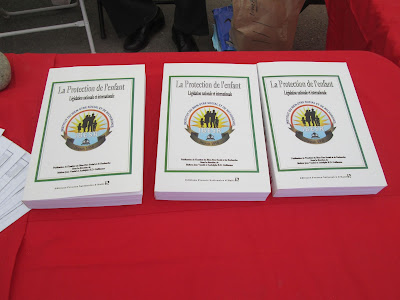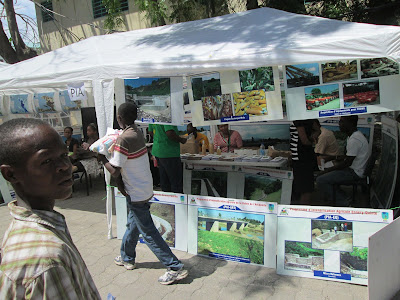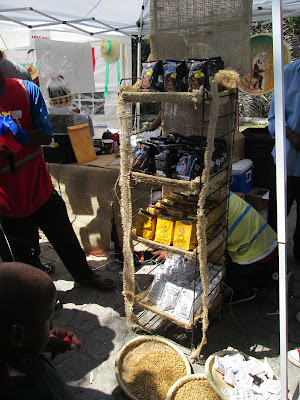Saturday, May 4, 2013
May 1st Agricultural Fair Photos - Part 3
We followed the 'papita' vendor ....
... and then looked to the right down the walkway where booths for haitian government organizations were set up.
Pangasius is a breed of fish that the cuban-haiti cooperation are introducing for fish farms.
Agriculture is the breadbasket of the country. Fish farms will provide fish as a source of protein.
We stopped at the booth for the Secretary of State For the Integration of Handicapped Persons. It is good to see the government promoting rights of the handicapped.
I met a man that I hadn't seen since before the earthquake. He attended St. Vincent's School For The Handicapped as a young boy. He started learning to paint at 8 years of ago. He is a quadruple amputee and this doesn't stop him from working. Whenever I was at St. Vincent' I would always see him standing near the offices wearing his 4 prosthetics. He is a very determined man and a good painter!
"Change Life" is a book published in creole and available for purchase.
We picked up some brochures and posters.
Pray for the handicapped of Haiti. This man is a quadriplegic and never gave up. He found a way to learn a trade and is now able to help support himself with the painting skills he has learned and practised since he was a young boy.
The booth of the Haitian Social Services, IBESR had brochures and a book on "The Protection of the Child". Unicef is very active in Haiti providing assistance and support to IBESR.
We stopped by the booth of the Haitian Agricultural Ministry.
We purchased some cd's from this man about studies that the government has conducted on farming.
Different projects that are ongoing are on display at this booth.
Fertiliser is needed for the farms in Haiti. Over the years farm productivity has decreased. In the mountains of Kenscoff, farmers are complaining that their crop yields decrease each year.
Haiti used to have a sugar factory. Imports of sugar led to the shutting down of the factory. A Haiti-Cuban partnership is aimed at restarting the sugar factory in Darbonne so that the country can reduce imports of sugar.
We stopped by a booth to pick up some posters and pamphlets on diseases and pests affecting haitian crops.
"How to make a good tasting coffee" is the title of this sign board. The process from harvesting the ripe coffee bean to processing the bean.
This sign board explains the harvesting process of coffee beans.
Tools required for working as a coffee bean farmer.
Burlap sacs are used for the coffee bean storage.
Photos on harvesting the coffee beans.
The drying process for the coffee beans.
Different varieties of Haitian coffee beans are on display.
Coffee beans packaged and ground coffee on display to be sold.
Coffee seedlings. In Haiti coffee is grown in the mountain regions.
Haiti can produce good coffee. I am not a coffee drinker but love the smell of coffee :) Improving the coffee harvest yields is one goal for the coffee farmer. Again, over the years the importing of coffee has helped to almost destroy the livelihood of the haitian coffee farmer. I encourage that people drink haitian coffee while here in Haiti.
At this booth is SYFAAH, a Canadian-Haitian government collaboration for agricultural farming.
This booth shows equipment used in the production of rice.
TRANSAGRI is a haitian company that manufactures equipment used in rice farming.
Haitian hats for a warm sunny May 1st hoiday available for purchase!
Labels:
Photos
Subscribe to:
Post Comments (Atom)






























No comments:
Post a Comment